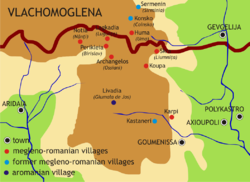Population exchange between Greece and Turkey
A population exchange between Greece and Turkey took place at the suggestion of the Greek government by the Treaty of Lausanne (1923). It took place according to religious criteria. The expulsion affected the Greek Orthodox in Anatolia and Izmir in Turkey and the Muslims in Greece and Crete. The exceptions were Greeks in Istanbul, East Thrace, and the islands of Gökçeada and Bozcaada in Turkey. Muslims living in Western Thrace in Greece and islands like Rhodes were allowed to stay.[1][2]
Population Exchange Between Greece And Turkey Media
The ghost town of Kayaköy (Livisi) in southwestern Anatolia. This Greek village was abandoned during the 1923 population exchange.
The minaret of what was once Tzistarakis Mosque in Athens has been removed and the building is currently a Museum of Greek Folk Art.
- Distribution of Anatolian Greeks in 1910:Demotic Greek speakers in yellow, Pontic Greek speakers in orange, and Cappadocian Greek speakers in green. Towns are shown as dots, and cities as squares.
Map of the settlements where the Megleno-Romanians live today. In Greece, near the border with North Macedonia, is the village of Notia. The vast majority of the population of Notia was sent to Turkey following the population exchange. Today, the population of this community is approximately 5,000 people in Turkey.
Declaration of Property during the Greek-Turkish population exchange from Yena (Kaynarca) to Thessaloniki (16 December 1927)
References
- ↑ "POPULATION EXCHANGE (MÜBADELE)". turkeyfromtheinside.com. Archived from the original on 2022-12-08. Retrieved 2022-12-08.
- ↑ Blanchard, Raoul (1925). "The Exchange of Populations between Greece and Turkey". Geographical Review. 15 (3): 449–456. doi:10.2307/208566. JSTOR 208566.
+{{{1}}}−{{{2}}}









